The Effects of Climate Change on Tourism to Great Barrier Reef
VerifiedAdded on 2022/12/22
|10
|2454
|64
Report
AI Summary
This report investigates the adverse effects of climate change on the tourism industry of the Great Barrier Reef in Australia. The study emphasizes the human-induced activities, such as the increased use of motor vehicles and industrial processes, as the primary drivers of climate change, which lead to environmental degradation, including coral bleaching and ocean acidification. The report examines the economic and environmental damage, highlighting the decline in coral reefs and the impact on sea life. It also explores the limitations of adaptation strategies and the importance of understanding human dimensions in mitigating climate risks. The report concludes that severe climate change is destroying the environmental factors and resources of the Great Barrier Reef and that the tourism industry is significantly affected, potentially leading to the depletion of this top tourism destination if the current situation continues.
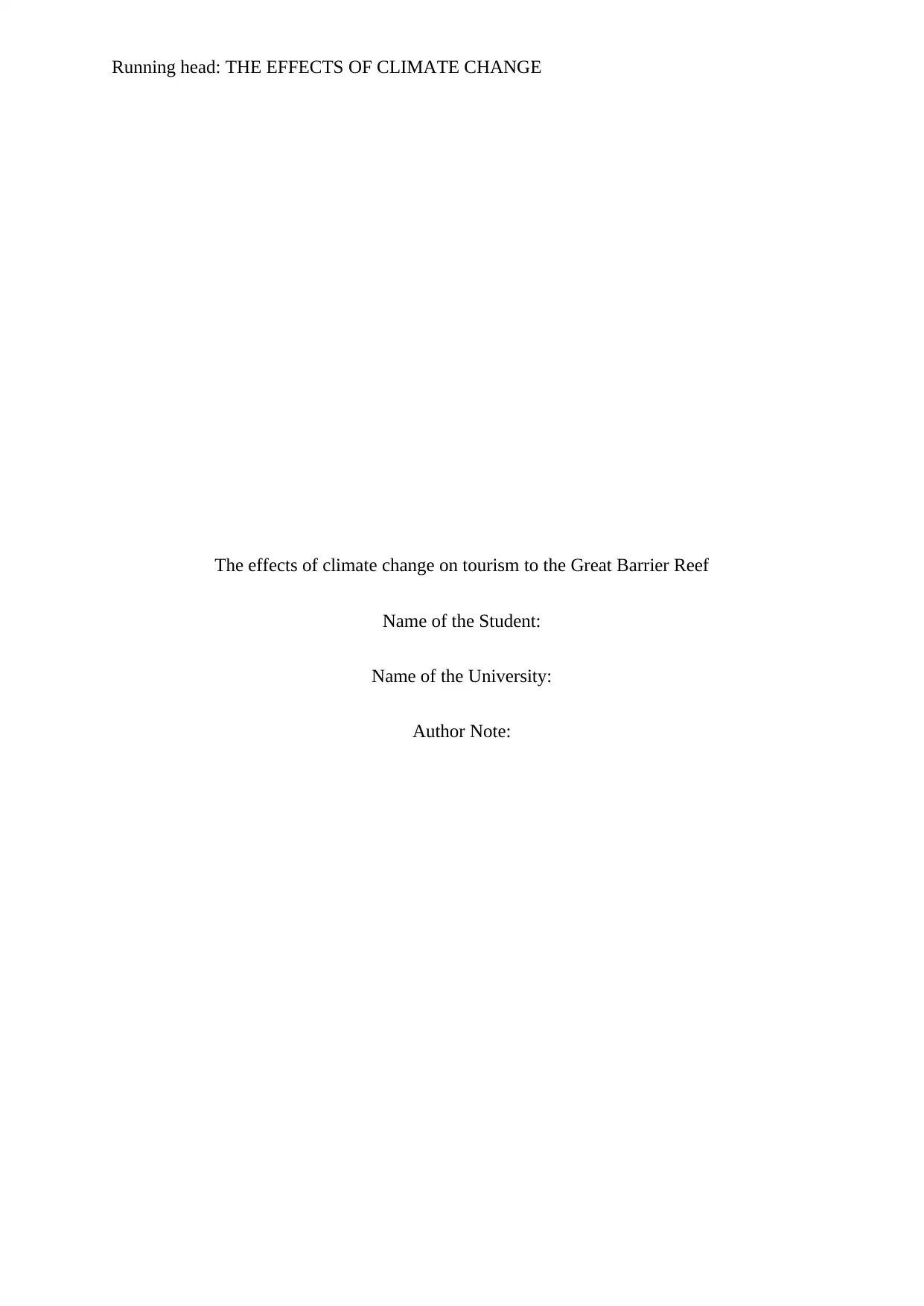
Running head: THE EFFECTS OF CLIMATE CHANGE
The effects of climate change on tourism to the Great Barrier Reef
Name of the Student:
Name of the University:
Author Note:
The effects of climate change on tourism to the Great Barrier Reef
Name of the Student:
Name of the University:
Author Note:
Paraphrase This Document
Need a fresh take? Get an instant paraphrase of this document with our AI Paraphraser
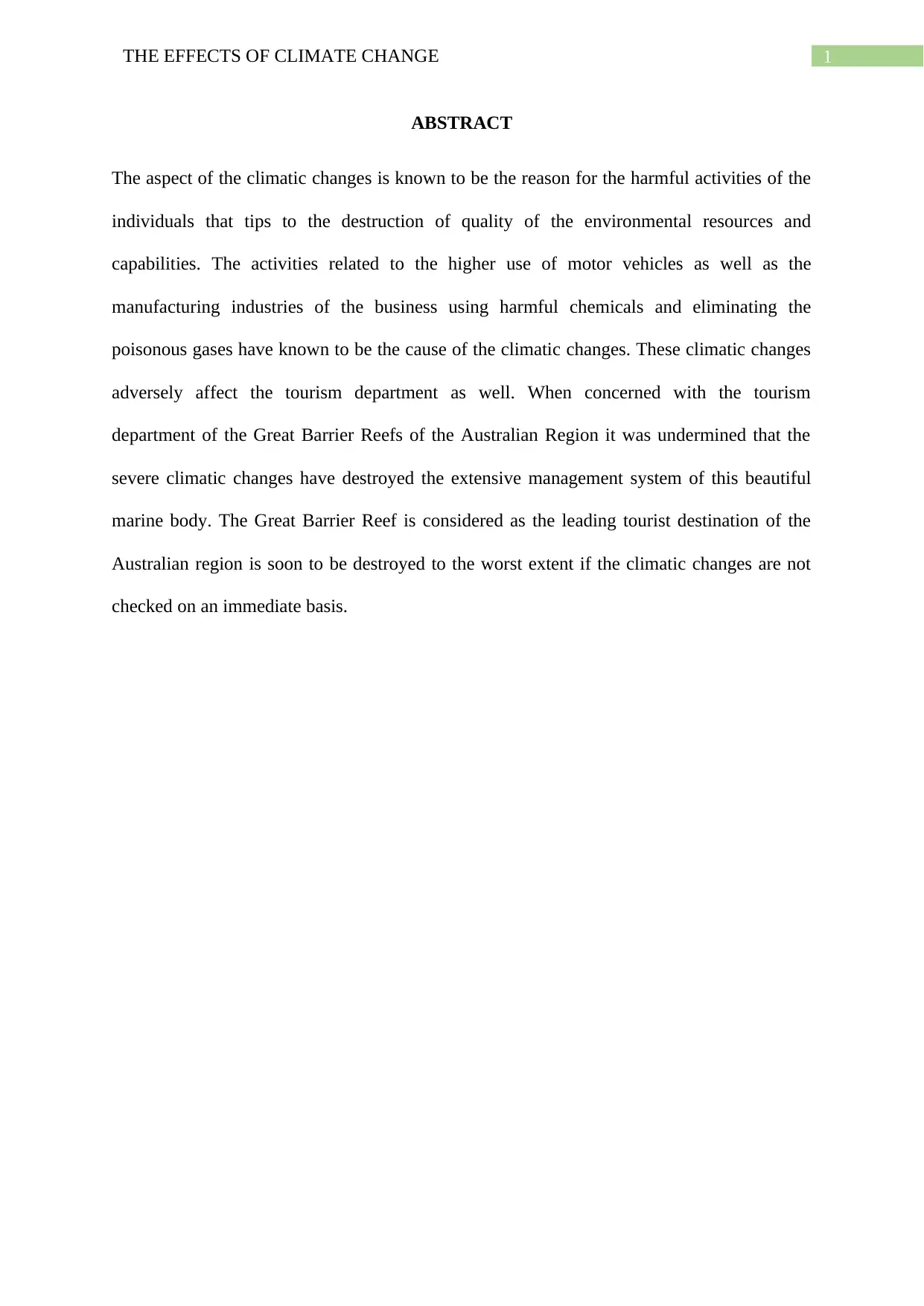
1THE EFFECTS OF CLIMATE CHANGE
ABSTRACT
The aspect of the climatic changes is known to be the reason for the harmful activities of the
individuals that tips to the destruction of quality of the environmental resources and
capabilities. The activities related to the higher use of motor vehicles as well as the
manufacturing industries of the business using harmful chemicals and eliminating the
poisonous gases have known to be the cause of the climatic changes. These climatic changes
adversely affect the tourism department as well. When concerned with the tourism
department of the Great Barrier Reefs of the Australian Region it was undermined that the
severe climatic changes have destroyed the extensive management system of this beautiful
marine body. The Great Barrier Reef is considered as the leading tourist destination of the
Australian region is soon to be destroyed to the worst extent if the climatic changes are not
checked on an immediate basis.
ABSTRACT
The aspect of the climatic changes is known to be the reason for the harmful activities of the
individuals that tips to the destruction of quality of the environmental resources and
capabilities. The activities related to the higher use of motor vehicles as well as the
manufacturing industries of the business using harmful chemicals and eliminating the
poisonous gases have known to be the cause of the climatic changes. These climatic changes
adversely affect the tourism department as well. When concerned with the tourism
department of the Great Barrier Reefs of the Australian Region it was undermined that the
severe climatic changes have destroyed the extensive management system of this beautiful
marine body. The Great Barrier Reef is considered as the leading tourist destination of the
Australian region is soon to be destroyed to the worst extent if the climatic changes are not
checked on an immediate basis.
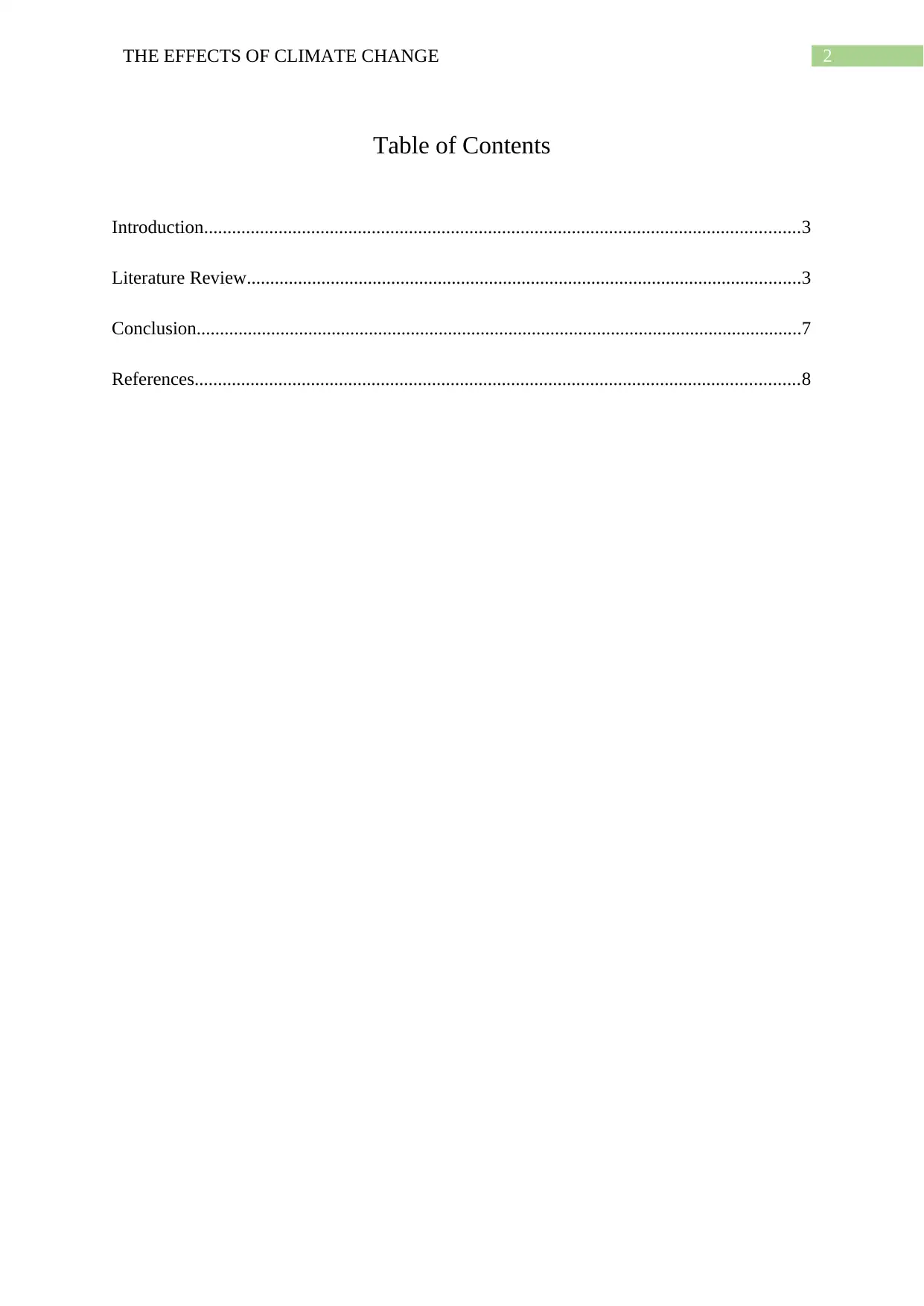
2THE EFFECTS OF CLIMATE CHANGE
Table of Contents
Introduction................................................................................................................................3
Literature Review.......................................................................................................................3
Conclusion..................................................................................................................................7
References..................................................................................................................................8
Table of Contents
Introduction................................................................................................................................3
Literature Review.......................................................................................................................3
Conclusion..................................................................................................................................7
References..................................................................................................................................8
⊘ This is a preview!⊘
Do you want full access?
Subscribe today to unlock all pages.

Trusted by 1+ million students worldwide
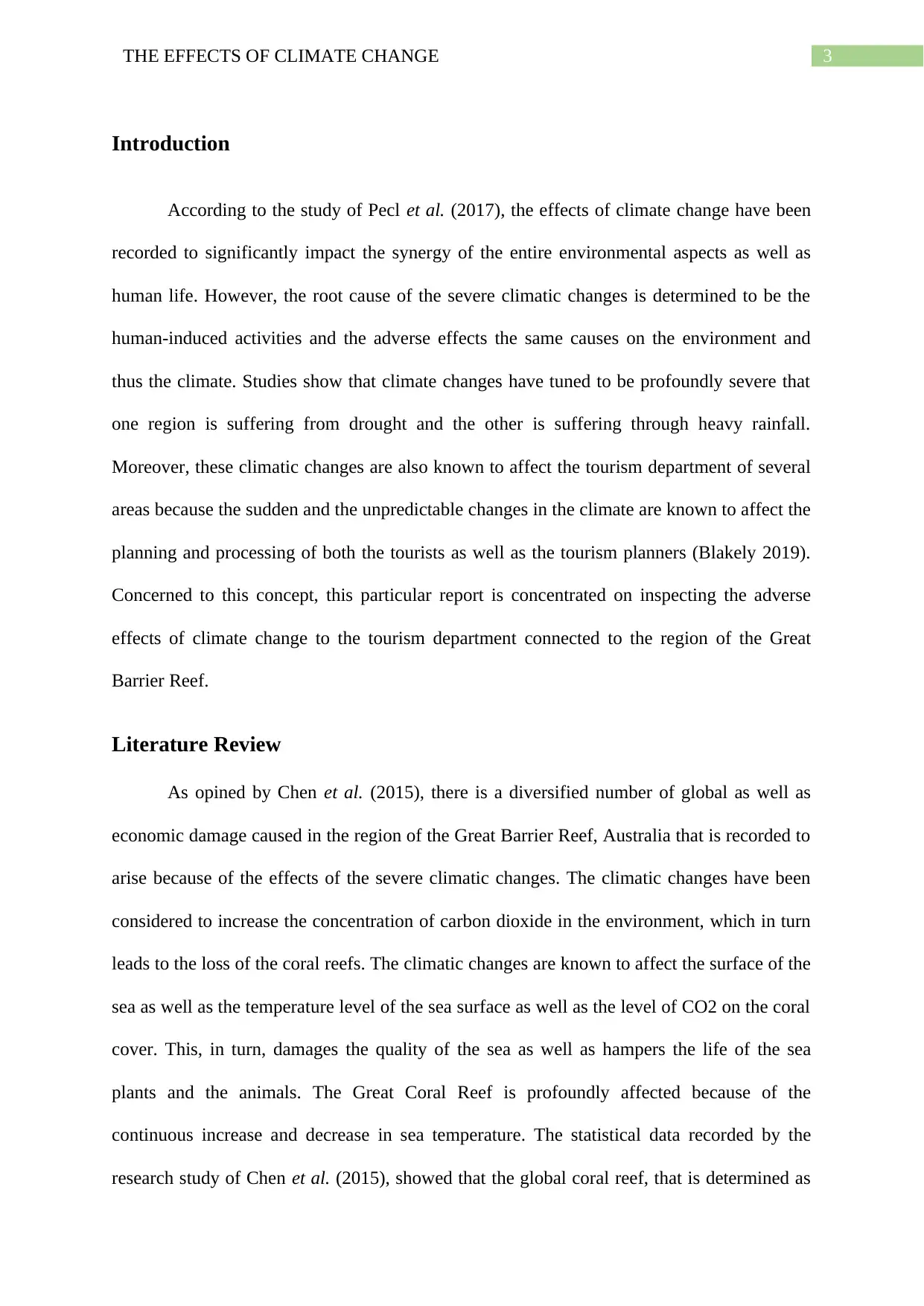
3THE EFFECTS OF CLIMATE CHANGE
Introduction
According to the study of Pecl et al. (2017), the effects of climate change have been
recorded to significantly impact the synergy of the entire environmental aspects as well as
human life. However, the root cause of the severe climatic changes is determined to be the
human-induced activities and the adverse effects the same causes on the environment and
thus the climate. Studies show that climate changes have tuned to be profoundly severe that
one region is suffering from drought and the other is suffering through heavy rainfall.
Moreover, these climatic changes are also known to affect the tourism department of several
areas because the sudden and the unpredictable changes in the climate are known to affect the
planning and processing of both the tourists as well as the tourism planners (Blakely 2019).
Concerned to this concept, this particular report is concentrated on inspecting the adverse
effects of climate change to the tourism department connected to the region of the Great
Barrier Reef.
Literature Review
As opined by Chen et al. (2015), there is a diversified number of global as well as
economic damage caused in the region of the Great Barrier Reef, Australia that is recorded to
arise because of the effects of the severe climatic changes. The climatic changes have been
considered to increase the concentration of carbon dioxide in the environment, which in turn
leads to the loss of the coral reefs. The climatic changes are known to affect the surface of the
sea as well as the temperature level of the sea surface as well as the level of CO2 on the coral
cover. This, in turn, damages the quality of the sea as well as hampers the life of the sea
plants and the animals. The Great Coral Reef is profoundly affected because of the
continuous increase and decrease in sea temperature. The statistical data recorded by the
research study of Chen et al. (2015), showed that the global coral reef, that is determined as
Introduction
According to the study of Pecl et al. (2017), the effects of climate change have been
recorded to significantly impact the synergy of the entire environmental aspects as well as
human life. However, the root cause of the severe climatic changes is determined to be the
human-induced activities and the adverse effects the same causes on the environment and
thus the climate. Studies show that climate changes have tuned to be profoundly severe that
one region is suffering from drought and the other is suffering through heavy rainfall.
Moreover, these climatic changes are also known to affect the tourism department of several
areas because the sudden and the unpredictable changes in the climate are known to affect the
planning and processing of both the tourists as well as the tourism planners (Blakely 2019).
Concerned to this concept, this particular report is concentrated on inspecting the adverse
effects of climate change to the tourism department connected to the region of the Great
Barrier Reef.
Literature Review
As opined by Chen et al. (2015), there is a diversified number of global as well as
economic damage caused in the region of the Great Barrier Reef, Australia that is recorded to
arise because of the effects of the severe climatic changes. The climatic changes have been
considered to increase the concentration of carbon dioxide in the environment, which in turn
leads to the loss of the coral reefs. The climatic changes are known to affect the surface of the
sea as well as the temperature level of the sea surface as well as the level of CO2 on the coral
cover. This, in turn, damages the quality of the sea as well as hampers the life of the sea
plants and the animals. The Great Coral Reef is profoundly affected because of the
continuous increase and decrease in sea temperature. The statistical data recorded by the
research study of Chen et al. (2015), showed that the global coral reef, that is determined as
Paraphrase This Document
Need a fresh take? Get an instant paraphrase of this document with our AI Paraphraser
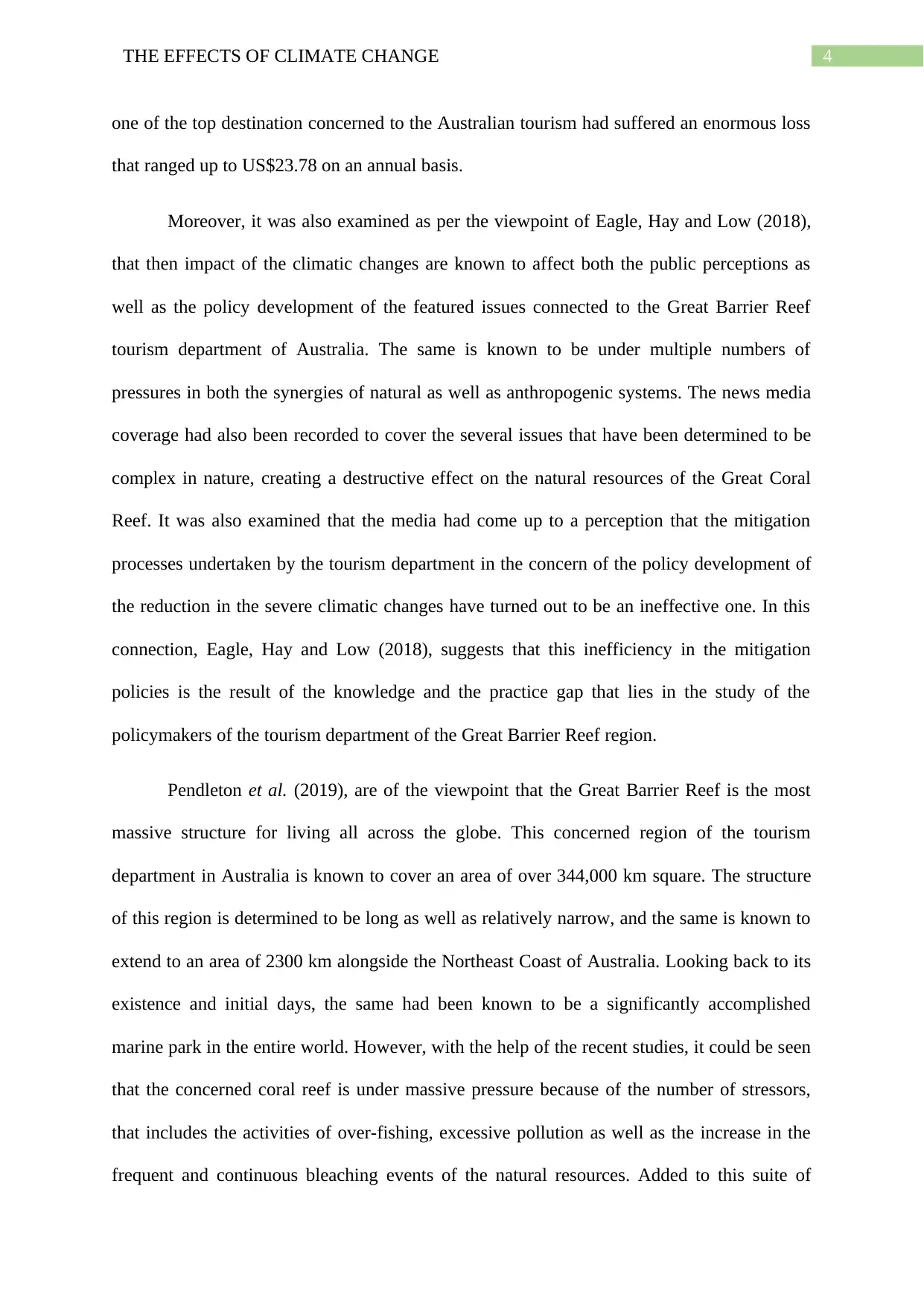
4THE EFFECTS OF CLIMATE CHANGE
one of the top destination concerned to the Australian tourism had suffered an enormous loss
that ranged up to US$23.78 on an annual basis.
Moreover, it was also examined as per the viewpoint of Eagle, Hay and Low (2018),
that then impact of the climatic changes are known to affect both the public perceptions as
well as the policy development of the featured issues connected to the Great Barrier Reef
tourism department of Australia. The same is known to be under multiple numbers of
pressures in both the synergies of natural as well as anthropogenic systems. The news media
coverage had also been recorded to cover the several issues that have been determined to be
complex in nature, creating a destructive effect on the natural resources of the Great Coral
Reef. It was also examined that the media had come up to a perception that the mitigation
processes undertaken by the tourism department in the concern of the policy development of
the reduction in the severe climatic changes have turned out to be an ineffective one. In this
connection, Eagle, Hay and Low (2018), suggests that this inefficiency in the mitigation
policies is the result of the knowledge and the practice gap that lies in the study of the
policymakers of the tourism department of the Great Barrier Reef region.
Pendleton et al. (2019), are of the viewpoint that the Great Barrier Reef is the most
massive structure for living all across the globe. This concerned region of the tourism
department in Australia is known to cover an area of over 344,000 km square. The structure
of this region is determined to be long as well as relatively narrow, and the same is known to
extend to an area of 2300 km alongside the Northeast Coast of Australia. Looking back to its
existence and initial days, the same had been known to be a significantly accomplished
marine park in the entire world. However, with the help of the recent studies, it could be seen
that the concerned coral reef is under massive pressure because of the number of stressors,
that includes the activities of over-fishing, excessive pollution as well as the increase in the
frequent and continuous bleaching events of the natural resources. Added to this suite of
one of the top destination concerned to the Australian tourism had suffered an enormous loss
that ranged up to US$23.78 on an annual basis.
Moreover, it was also examined as per the viewpoint of Eagle, Hay and Low (2018),
that then impact of the climatic changes are known to affect both the public perceptions as
well as the policy development of the featured issues connected to the Great Barrier Reef
tourism department of Australia. The same is known to be under multiple numbers of
pressures in both the synergies of natural as well as anthropogenic systems. The news media
coverage had also been recorded to cover the several issues that have been determined to be
complex in nature, creating a destructive effect on the natural resources of the Great Coral
Reef. It was also examined that the media had come up to a perception that the mitigation
processes undertaken by the tourism department in the concern of the policy development of
the reduction in the severe climatic changes have turned out to be an ineffective one. In this
connection, Eagle, Hay and Low (2018), suggests that this inefficiency in the mitigation
policies is the result of the knowledge and the practice gap that lies in the study of the
policymakers of the tourism department of the Great Barrier Reef region.
Pendleton et al. (2019), are of the viewpoint that the Great Barrier Reef is the most
massive structure for living all across the globe. This concerned region of the tourism
department in Australia is known to cover an area of over 344,000 km square. The structure
of this region is determined to be long as well as relatively narrow, and the same is known to
extend to an area of 2300 km alongside the Northeast Coast of Australia. Looking back to its
existence and initial days, the same had been known to be a significantly accomplished
marine park in the entire world. However, with the help of the recent studies, it could be seen
that the concerned coral reef is under massive pressure because of the number of stressors,
that includes the activities of over-fishing, excessive pollution as well as the increase in the
frequent and continuous bleaching events of the natural resources. Added to this suite of
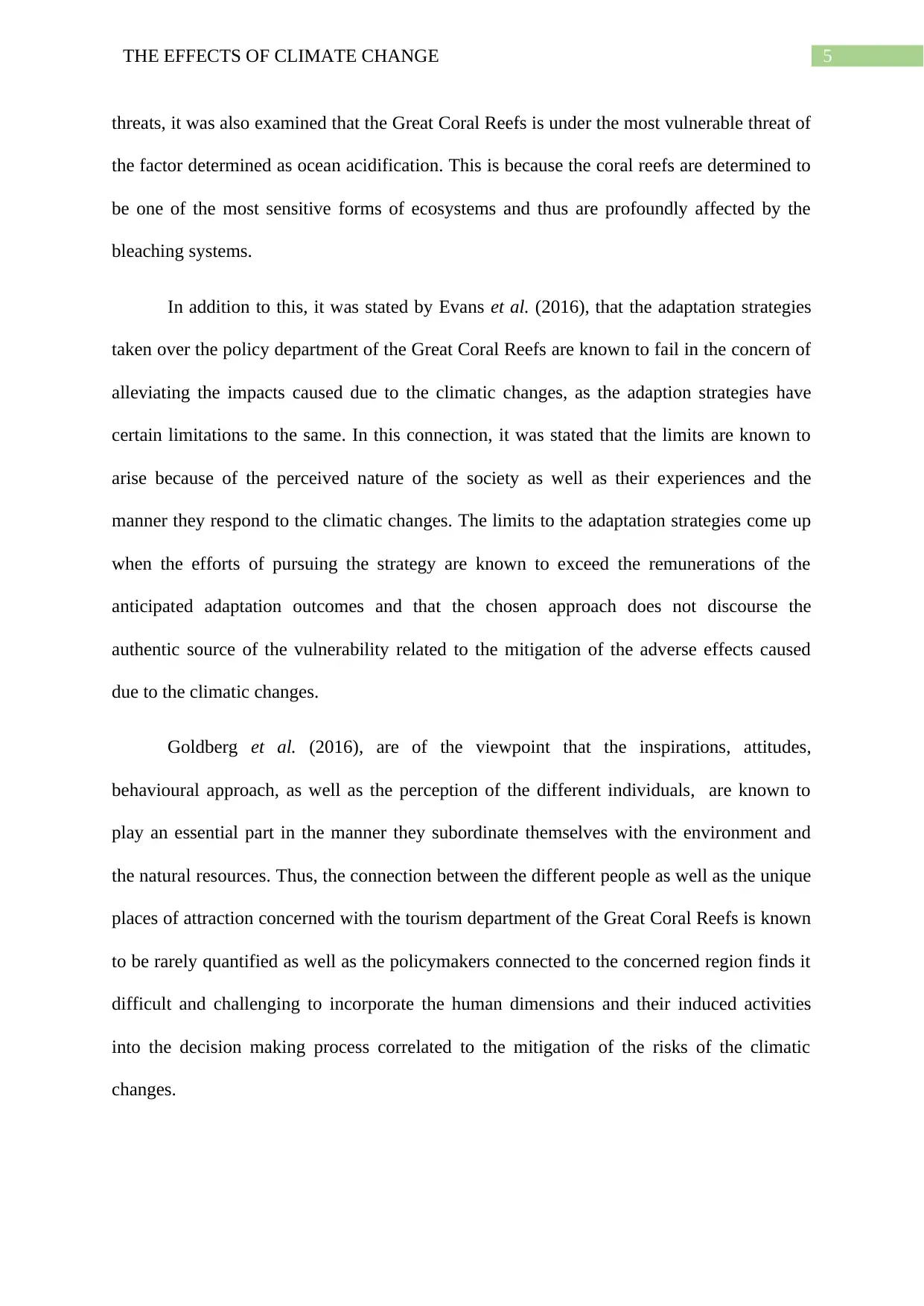
5THE EFFECTS OF CLIMATE CHANGE
threats, it was also examined that the Great Coral Reefs is under the most vulnerable threat of
the factor determined as ocean acidification. This is because the coral reefs are determined to
be one of the most sensitive forms of ecosystems and thus are profoundly affected by the
bleaching systems.
In addition to this, it was stated by Evans et al. (2016), that the adaptation strategies
taken over the policy department of the Great Coral Reefs are known to fail in the concern of
alleviating the impacts caused due to the climatic changes, as the adaption strategies have
certain limitations to the same. In this connection, it was stated that the limits are known to
arise because of the perceived nature of the society as well as their experiences and the
manner they respond to the climatic changes. The limits to the adaptation strategies come up
when the efforts of pursuing the strategy are known to exceed the remunerations of the
anticipated adaptation outcomes and that the chosen approach does not discourse the
authentic source of the vulnerability related to the mitigation of the adverse effects caused
due to the climatic changes.
Goldberg et al. (2016), are of the viewpoint that the inspirations, attitudes,
behavioural approach, as well as the perception of the different individuals, are known to
play an essential part in the manner they subordinate themselves with the environment and
the natural resources. Thus, the connection between the different people as well as the unique
places of attraction concerned with the tourism department of the Great Coral Reefs is known
to be rarely quantified as well as the policymakers connected to the concerned region finds it
difficult and challenging to incorporate the human dimensions and their induced activities
into the decision making process correlated to the mitigation of the risks of the climatic
changes.
threats, it was also examined that the Great Coral Reefs is under the most vulnerable threat of
the factor determined as ocean acidification. This is because the coral reefs are determined to
be one of the most sensitive forms of ecosystems and thus are profoundly affected by the
bleaching systems.
In addition to this, it was stated by Evans et al. (2016), that the adaptation strategies
taken over the policy department of the Great Coral Reefs are known to fail in the concern of
alleviating the impacts caused due to the climatic changes, as the adaption strategies have
certain limitations to the same. In this connection, it was stated that the limits are known to
arise because of the perceived nature of the society as well as their experiences and the
manner they respond to the climatic changes. The limits to the adaptation strategies come up
when the efforts of pursuing the strategy are known to exceed the remunerations of the
anticipated adaptation outcomes and that the chosen approach does not discourse the
authentic source of the vulnerability related to the mitigation of the adverse effects caused
due to the climatic changes.
Goldberg et al. (2016), are of the viewpoint that the inspirations, attitudes,
behavioural approach, as well as the perception of the different individuals, are known to
play an essential part in the manner they subordinate themselves with the environment and
the natural resources. Thus, the connection between the different people as well as the unique
places of attraction concerned with the tourism department of the Great Coral Reefs is known
to be rarely quantified as well as the policymakers connected to the concerned region finds it
difficult and challenging to incorporate the human dimensions and their induced activities
into the decision making process correlated to the mitigation of the risks of the climatic
changes.
⊘ This is a preview!⊘
Do you want full access?
Subscribe today to unlock all pages.

Trusted by 1+ million students worldwide
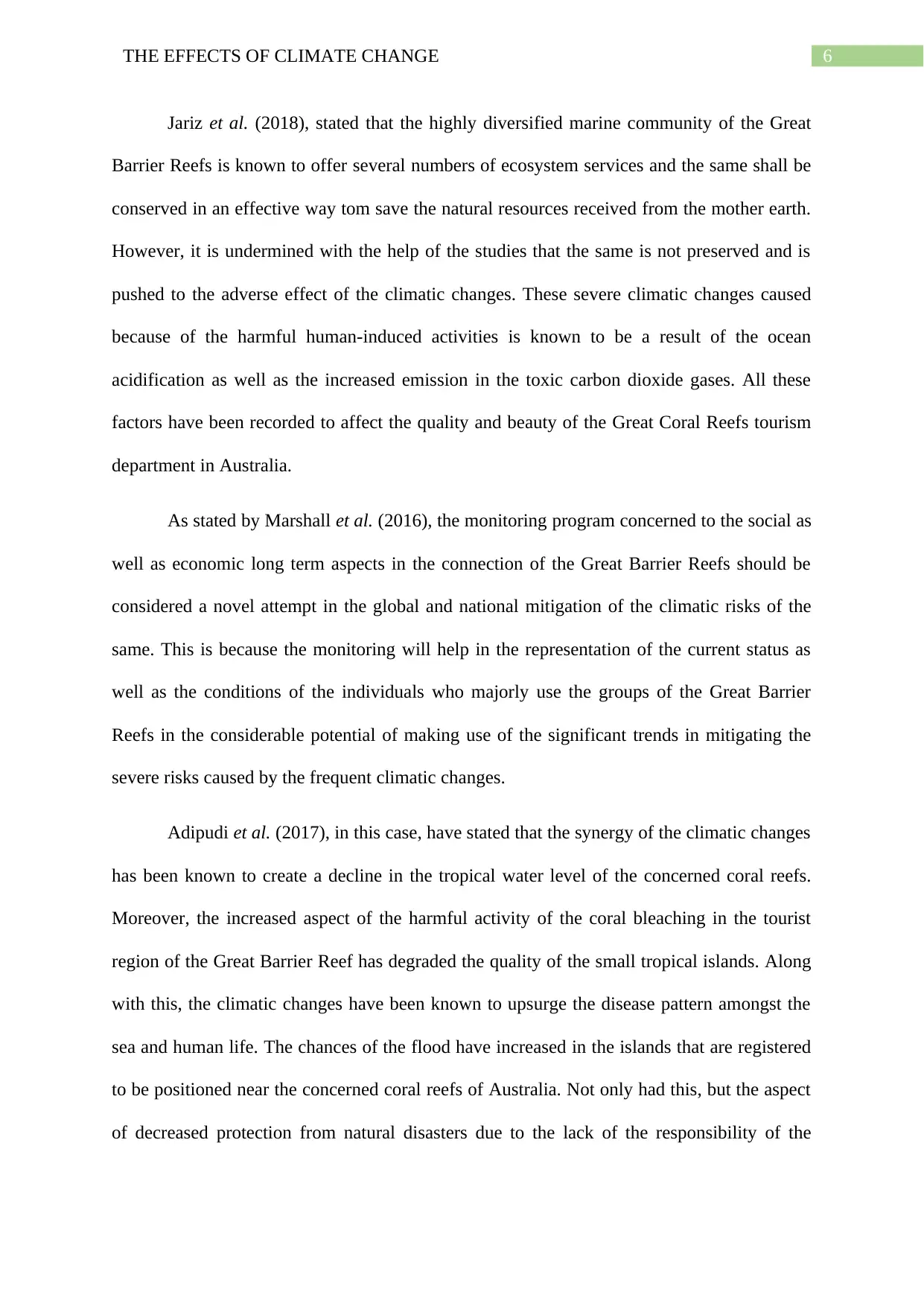
6THE EFFECTS OF CLIMATE CHANGE
Jariz et al. (2018), stated that the highly diversified marine community of the Great
Barrier Reefs is known to offer several numbers of ecosystem services and the same shall be
conserved in an effective way tom save the natural resources received from the mother earth.
However, it is undermined with the help of the studies that the same is not preserved and is
pushed to the adverse effect of the climatic changes. These severe climatic changes caused
because of the harmful human-induced activities is known to be a result of the ocean
acidification as well as the increased emission in the toxic carbon dioxide gases. All these
factors have been recorded to affect the quality and beauty of the Great Coral Reefs tourism
department in Australia.
As stated by Marshall et al. (2016), the monitoring program concerned to the social as
well as economic long term aspects in the connection of the Great Barrier Reefs should be
considered a novel attempt in the global and national mitigation of the climatic risks of the
same. This is because the monitoring will help in the representation of the current status as
well as the conditions of the individuals who majorly use the groups of the Great Barrier
Reefs in the considerable potential of making use of the significant trends in mitigating the
severe risks caused by the frequent climatic changes.
Adipudi et al. (2017), in this case, have stated that the synergy of the climatic changes
has been known to create a decline in the tropical water level of the concerned coral reefs.
Moreover, the increased aspect of the harmful activity of the coral bleaching in the tourist
region of the Great Barrier Reef has degraded the quality of the small tropical islands. Along
with this, the climatic changes have been known to upsurge the disease pattern amongst the
sea and human life. The chances of the flood have increased in the islands that are registered
to be positioned near the concerned coral reefs of Australia. Not only had this, but the aspect
of decreased protection from natural disasters due to the lack of the responsibility of the
Jariz et al. (2018), stated that the highly diversified marine community of the Great
Barrier Reefs is known to offer several numbers of ecosystem services and the same shall be
conserved in an effective way tom save the natural resources received from the mother earth.
However, it is undermined with the help of the studies that the same is not preserved and is
pushed to the adverse effect of the climatic changes. These severe climatic changes caused
because of the harmful human-induced activities is known to be a result of the ocean
acidification as well as the increased emission in the toxic carbon dioxide gases. All these
factors have been recorded to affect the quality and beauty of the Great Coral Reefs tourism
department in Australia.
As stated by Marshall et al. (2016), the monitoring program concerned to the social as
well as economic long term aspects in the connection of the Great Barrier Reefs should be
considered a novel attempt in the global and national mitigation of the climatic risks of the
same. This is because the monitoring will help in the representation of the current status as
well as the conditions of the individuals who majorly use the groups of the Great Barrier
Reefs in the considerable potential of making use of the significant trends in mitigating the
severe risks caused by the frequent climatic changes.
Adipudi et al. (2017), in this case, have stated that the synergy of the climatic changes
has been known to create a decline in the tropical water level of the concerned coral reefs.
Moreover, the increased aspect of the harmful activity of the coral bleaching in the tourist
region of the Great Barrier Reef has degraded the quality of the small tropical islands. Along
with this, the climatic changes have been known to upsurge the disease pattern amongst the
sea and human life. The chances of the flood have increased in the islands that are registered
to be positioned near the concerned coral reefs of Australia. Not only had this, but the aspect
of decreased protection from natural disasters due to the lack of the responsibility of the
Paraphrase This Document
Need a fresh take? Get an instant paraphrase of this document with our AI Paraphraser
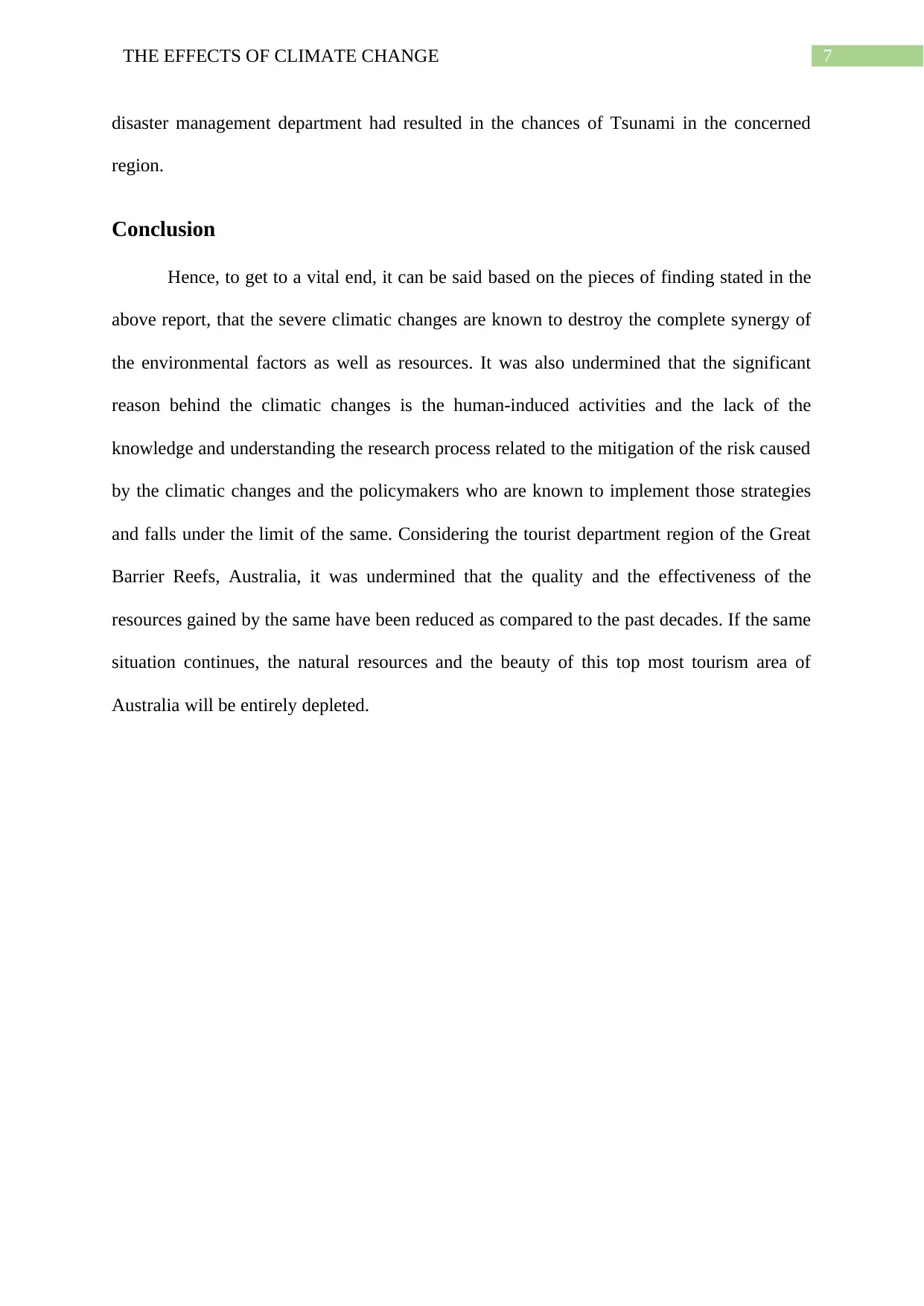
7THE EFFECTS OF CLIMATE CHANGE
disaster management department had resulted in the chances of Tsunami in the concerned
region.
Conclusion
Hence, to get to a vital end, it can be said based on the pieces of finding stated in the
above report, that the severe climatic changes are known to destroy the complete synergy of
the environmental factors as well as resources. It was also undermined that the significant
reason behind the climatic changes is the human-induced activities and the lack of the
knowledge and understanding the research process related to the mitigation of the risk caused
by the climatic changes and the policymakers who are known to implement those strategies
and falls under the limit of the same. Considering the tourist department region of the Great
Barrier Reefs, Australia, it was undermined that the quality and the effectiveness of the
resources gained by the same have been reduced as compared to the past decades. If the same
situation continues, the natural resources and the beauty of this top most tourism area of
Australia will be entirely depleted.
disaster management department had resulted in the chances of Tsunami in the concerned
region.
Conclusion
Hence, to get to a vital end, it can be said based on the pieces of finding stated in the
above report, that the severe climatic changes are known to destroy the complete synergy of
the environmental factors as well as resources. It was also undermined that the significant
reason behind the climatic changes is the human-induced activities and the lack of the
knowledge and understanding the research process related to the mitigation of the risk caused
by the climatic changes and the policymakers who are known to implement those strategies
and falls under the limit of the same. Considering the tourist department region of the Great
Barrier Reefs, Australia, it was undermined that the quality and the effectiveness of the
resources gained by the same have been reduced as compared to the past decades. If the same
situation continues, the natural resources and the beauty of this top most tourism area of
Australia will be entirely depleted.
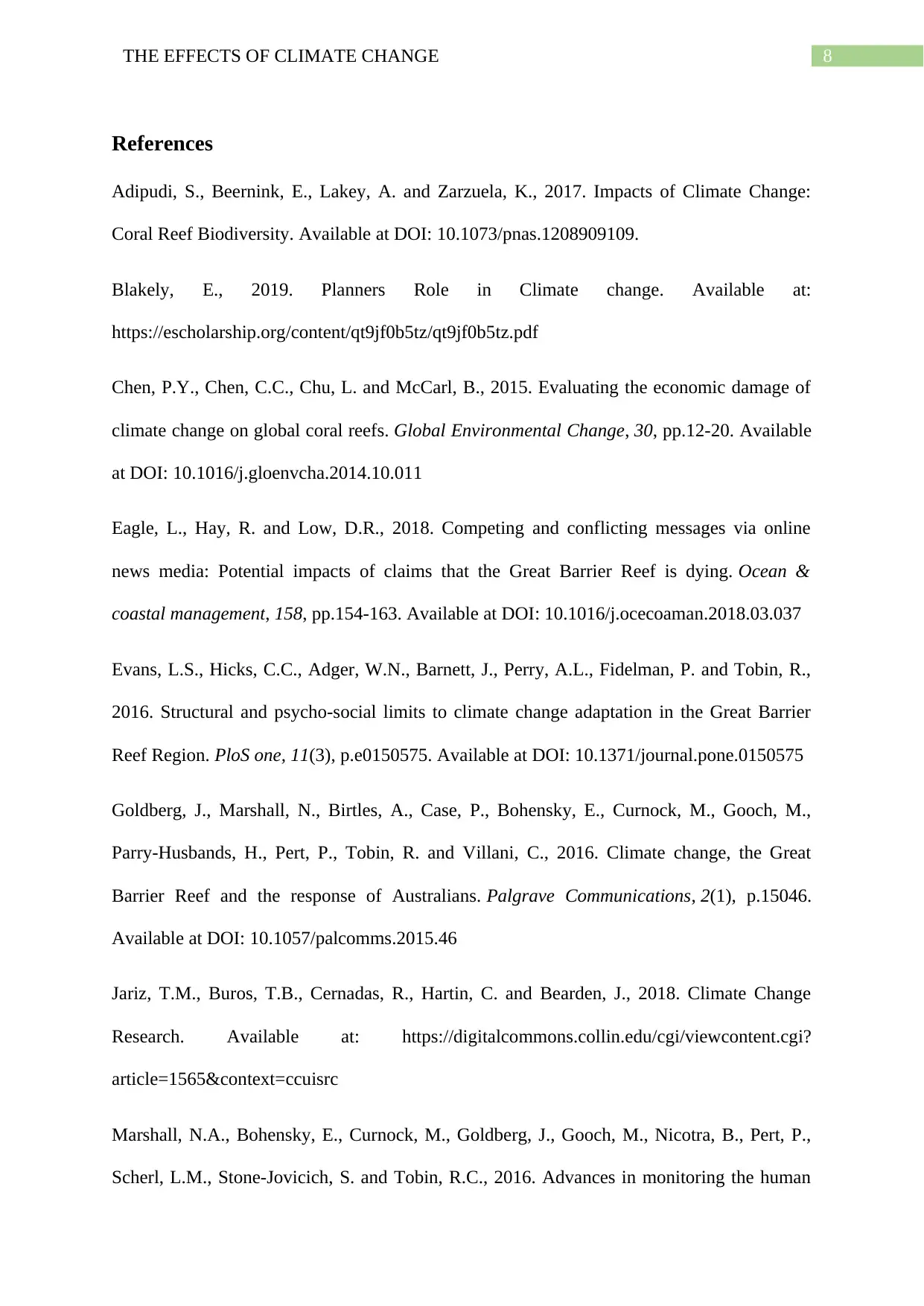
8THE EFFECTS OF CLIMATE CHANGE
References
Adipudi, S., Beernink, E., Lakey, A. and Zarzuela, K., 2017. Impacts of Climate Change:
Coral Reef Biodiversity. Available at DOI: 10.1073/pnas.1208909109.
Blakely, E., 2019. Planners Role in Climate change. Available at:
https://escholarship.org/content/qt9jf0b5tz/qt9jf0b5tz.pdf
Chen, P.Y., Chen, C.C., Chu, L. and McCarl, B., 2015. Evaluating the economic damage of
climate change on global coral reefs. Global Environmental Change, 30, pp.12-20. Available
at DOI: 10.1016/j.gloenvcha.2014.10.011
Eagle, L., Hay, R. and Low, D.R., 2018. Competing and conflicting messages via online
news media: Potential impacts of claims that the Great Barrier Reef is dying. Ocean &
coastal management, 158, pp.154-163. Available at DOI: 10.1016/j.ocecoaman.2018.03.037
Evans, L.S., Hicks, C.C., Adger, W.N., Barnett, J., Perry, A.L., Fidelman, P. and Tobin, R.,
2016. Structural and psycho-social limits to climate change adaptation in the Great Barrier
Reef Region. PloS one, 11(3), p.e0150575. Available at DOI: 10.1371/journal.pone.0150575
Goldberg, J., Marshall, N., Birtles, A., Case, P., Bohensky, E., Curnock, M., Gooch, M.,
Parry-Husbands, H., Pert, P., Tobin, R. and Villani, C., 2016. Climate change, the Great
Barrier Reef and the response of Australians. Palgrave Communications, 2(1), p.15046.
Available at DOI: 10.1057/palcomms.2015.46
Jariz, T.M., Buros, T.B., Cernadas, R., Hartin, C. and Bearden, J., 2018. Climate Change
Research. Available at: https://digitalcommons.collin.edu/cgi/viewcontent.cgi?
article=1565&context=ccuisrc
Marshall, N.A., Bohensky, E., Curnock, M., Goldberg, J., Gooch, M., Nicotra, B., Pert, P.,
Scherl, L.M., Stone-Jovicich, S. and Tobin, R.C., 2016. Advances in monitoring the human
References
Adipudi, S., Beernink, E., Lakey, A. and Zarzuela, K., 2017. Impacts of Climate Change:
Coral Reef Biodiversity. Available at DOI: 10.1073/pnas.1208909109.
Blakely, E., 2019. Planners Role in Climate change. Available at:
https://escholarship.org/content/qt9jf0b5tz/qt9jf0b5tz.pdf
Chen, P.Y., Chen, C.C., Chu, L. and McCarl, B., 2015. Evaluating the economic damage of
climate change on global coral reefs. Global Environmental Change, 30, pp.12-20. Available
at DOI: 10.1016/j.gloenvcha.2014.10.011
Eagle, L., Hay, R. and Low, D.R., 2018. Competing and conflicting messages via online
news media: Potential impacts of claims that the Great Barrier Reef is dying. Ocean &
coastal management, 158, pp.154-163. Available at DOI: 10.1016/j.ocecoaman.2018.03.037
Evans, L.S., Hicks, C.C., Adger, W.N., Barnett, J., Perry, A.L., Fidelman, P. and Tobin, R.,
2016. Structural and psycho-social limits to climate change adaptation in the Great Barrier
Reef Region. PloS one, 11(3), p.e0150575. Available at DOI: 10.1371/journal.pone.0150575
Goldberg, J., Marshall, N., Birtles, A., Case, P., Bohensky, E., Curnock, M., Gooch, M.,
Parry-Husbands, H., Pert, P., Tobin, R. and Villani, C., 2016. Climate change, the Great
Barrier Reef and the response of Australians. Palgrave Communications, 2(1), p.15046.
Available at DOI: 10.1057/palcomms.2015.46
Jariz, T.M., Buros, T.B., Cernadas, R., Hartin, C. and Bearden, J., 2018. Climate Change
Research. Available at: https://digitalcommons.collin.edu/cgi/viewcontent.cgi?
article=1565&context=ccuisrc
Marshall, N.A., Bohensky, E., Curnock, M., Goldberg, J., Gooch, M., Nicotra, B., Pert, P.,
Scherl, L.M., Stone-Jovicich, S. and Tobin, R.C., 2016. Advances in monitoring the human
⊘ This is a preview!⊘
Do you want full access?
Subscribe today to unlock all pages.

Trusted by 1+ million students worldwide
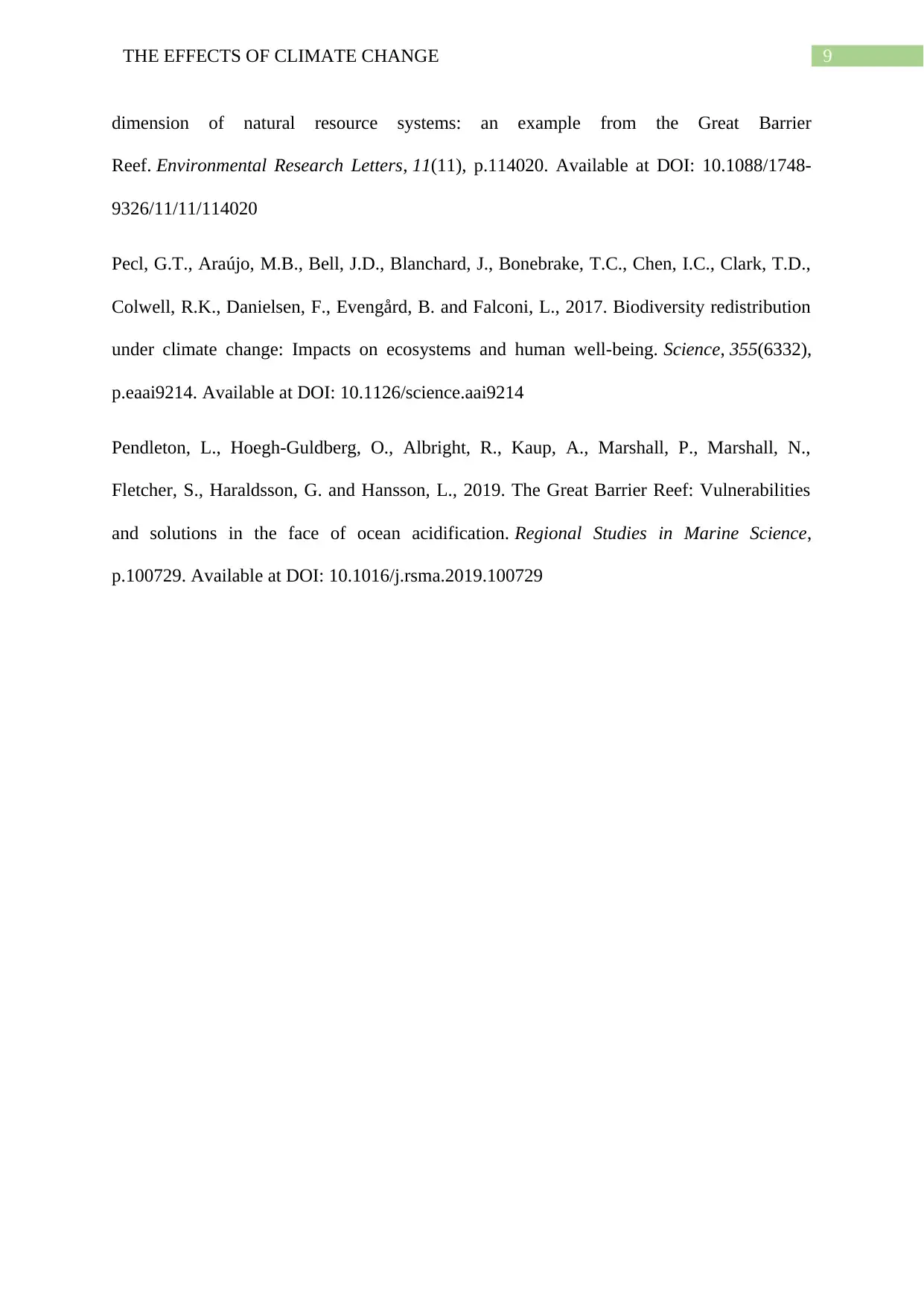
9THE EFFECTS OF CLIMATE CHANGE
dimension of natural resource systems: an example from the Great Barrier
Reef. Environmental Research Letters, 11(11), p.114020. Available at DOI: 10.1088/1748-
9326/11/11/114020
Pecl, G.T., Araújo, M.B., Bell, J.D., Blanchard, J., Bonebrake, T.C., Chen, I.C., Clark, T.D.,
Colwell, R.K., Danielsen, F., Evengård, B. and Falconi, L., 2017. Biodiversity redistribution
under climate change: Impacts on ecosystems and human well-being. Science, 355(6332),
p.eaai9214. Available at DOI: 10.1126/science.aai9214
Pendleton, L., Hoegh-Guldberg, O., Albright, R., Kaup, A., Marshall, P., Marshall, N.,
Fletcher, S., Haraldsson, G. and Hansson, L., 2019. The Great Barrier Reef: Vulnerabilities
and solutions in the face of ocean acidification. Regional Studies in Marine Science,
p.100729. Available at DOI: 10.1016/j.rsma.2019.100729
dimension of natural resource systems: an example from the Great Barrier
Reef. Environmental Research Letters, 11(11), p.114020. Available at DOI: 10.1088/1748-
9326/11/11/114020
Pecl, G.T., Araújo, M.B., Bell, J.D., Blanchard, J., Bonebrake, T.C., Chen, I.C., Clark, T.D.,
Colwell, R.K., Danielsen, F., Evengård, B. and Falconi, L., 2017. Biodiversity redistribution
under climate change: Impacts on ecosystems and human well-being. Science, 355(6332),
p.eaai9214. Available at DOI: 10.1126/science.aai9214
Pendleton, L., Hoegh-Guldberg, O., Albright, R., Kaup, A., Marshall, P., Marshall, N.,
Fletcher, S., Haraldsson, G. and Hansson, L., 2019. The Great Barrier Reef: Vulnerabilities
and solutions in the face of ocean acidification. Regional Studies in Marine Science,
p.100729. Available at DOI: 10.1016/j.rsma.2019.100729
1 out of 10
Related Documents
Your All-in-One AI-Powered Toolkit for Academic Success.
+13062052269
info@desklib.com
Available 24*7 on WhatsApp / Email
![[object Object]](/_next/static/media/star-bottom.7253800d.svg)
Unlock your academic potential
Copyright © 2020–2025 A2Z Services. All Rights Reserved. Developed and managed by ZUCOL.





